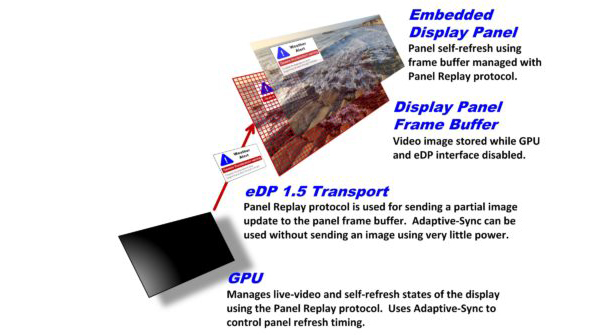Embedded DisplayPort 1.5 Adds Power, Video Playback Updates For Laptops
No more skipped frames while watching movies or Twitch
The Video Electronics Standards Association (VESA) has announced a new Embedded DisplayPort standard (eDP) called version 1.5, succeeding version 1.4b which was released in 2015. Revision 1.5 adds several more enhancements to the DisplayPort feature set that will improve laptop battery life and provide butter smooth video playback with Adaptive-Sync capable displays.
By far the biggest feature of eDP 1.5 is the addition of panel self-refresh capability. This feature allows the display to store static images in its own display memory, giving parts of the graphical interface a chance to enter a sleep state or standby mode.
This means the GPU is completely disconnected from the display when the graphical interface is idling, thus saving extra power. It also gives the GPU a chance to enter a sleep state and consume even less power. Current GPUs only run at an idle clock speed when idling and cannot enter a sleep state or you would lose video signal (unlike CPU cores which already can).
Another power-saving protocol being added is the ability for the display to disable itself during normal operation, during the vertical blanking period. There's also added protocol support for OLED panels to improve power savings and longevity for those screens.

Adaptive-Sync Video Playback Support
The next major feature added is Adaptive-Sync support for movie and video streaming playback. On eDP 1.5 capable screens, the display can match its refresh rate to the frame rate of a video that is being played to reduce stutter (frame duplication) and frame skipping.
For high refresh gaming displays, new mechanisms have been added to reduce display flicker.
These Features Are Not in Regular DisplayPort Yet
Keep in mind, Embedded DisplayPort differs greatly from the standard DisplayPort protocol we're familiar with in regular monitors and graphics cards. eDP only applies to tablets, laptops, handheld gaming consoles, and other devices where the display is directly integrated into the device. eDP adds features and capabilities for optimizing the connection between the integrated display and its associated device that cannot be done with regular DisplayPort. One such capability of eDP is supplying backlight power directly to a LCD panel - through the DisplayPort connection, without the requirement of an any additional power outputs or inputs.
Get Tom's Hardware's best news and in-depth reviews, straight to your inbox.
So all the features being added in eDP 1.5 are not being added to regular DisplayPort monitors and GPUs. We'll have to wait for a new (regular) DisplayPort protocol to see if any of these features make their way to regular monitors and desktops.

Aaron Klotz is a contributing writer for Tom’s Hardware, covering news related to computer hardware such as CPUs, and graphics cards.